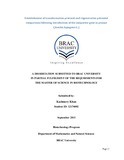Establishment of transformation protocol and regeneration potential comparison following introduction of the antiporter gene in peanut (Arachis hypogaea L.)
Abstract
Peanut is a cash crop which is cultivated in 24 million ha all over the world for extracting edible oil. It is a great food having outstanding food values, specially for hunger and malnutrition affecting Asian countries like Bangladesh. But peanut yield is substantially reduced because of abiotic stresses like salinity. As a result, salt tolerance in peanut has to be improved to ensure better production where the success of conventional breeding severely hampered due to its cleistogamous nature of pollination. Therefore, Agrobacterium- mediated genetic transformation may lead the solution. On that context, present investigation was carried out with three Bangladeshi peanut varieties, such as, BINA Chinabadam 2, BINA Chinabadam 4 and BINA Chinabadam 6 using two explants, named, decapitated half embryo and embryonic leaflet. Factors influencing transformation and comparing the regeneration potential of explants on selection media `was done using three different vectors, named, pBI121, pK7WG2_OsNHX1_1.6 & pK7WG2_AtNHX1_1.6. Decapitated half embryo showed better in vitro regeneration potential than leaflet explant. Hence, transformation study was conducted with 1 day old decapitated half embryo where highest percentage of GUS positive explants were found when OD600 was more than 1 at 60 minutes of infection and 3 days of co-cultivation duration in transient assay. Regeneration efficiency on selection media containing 50mg/l kanamycin was higher in almost all three varieties. In contrast to this, untransformed control explants were able to resist upto 20mg/l of kanamycin. Moreover, average number of putative transformed shoots was gradually dropped with the increased concentration of kanamycin. Shoots which survived upto 150mg/l kanamycin were transferred into rooting media for root induction. Finally transformation efficiency was evaluated by calculating the percentage of GUS positive plant parts, such as, leaf, stem and roots among the putatively transformed plantlets. Maximum transformation frequency (14.28%) was observed in BINA Chinabadam 4. In the current experiment, effect of salinity on peanut seed germination was also observed. The germination rate steadily decreased with the increase of NaCl in the media and finally no germination was observed in MS media supplemented with 150mM of NaCl and above.

